Top News
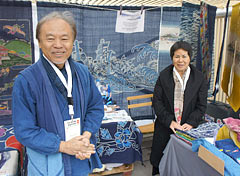
April 30, 2012 Yoko Oshiro, Correspondent of Ryukyu Shimpo
Jardin d’Acclimatation is a park located in the Boulogne Forest on the outskirts of Paris. Peacocks and other birds abound in a mixture of a natural and amusement park seldom seen in Japan.
A Japan Festival was held at the Jardin d’Acclimatation from April 7 to May 8. The diverse range of products and art crafts from all over Japan displayed in a booth designed by a budding architect attracted great attention.
Masanao Shiroma, Ryukyuan dyeing artist and representative of the factory Aikaze participated in the event from April 7 to 20 and put his creations up for sale.
To begin with, he wondered if people would really be interested in his works because they would be too busy enjoying themselves in the amusement park, but his concerns turned out to be groundless. Shiroma’s beautiful indigo dyeing attracted many visitors.
He explained that he avoided using chemical dyes and only used natural dye compounds in his work, visitors were also impressed and the works sold well in the booth. Visitors spent much more than they would have expected on such an outing but seemed very happy with the purchases they made.
A resident of Paris, said, “I was looking for a housewarming gift for my friend and I found some place mats in Shiroma’s booth. Okinawan traditional patterns are beautiful and I think they will make an excellent gift. I’m sure that my friend will really like them.”
The festival lasted for a month until May 8, with the park infused with a Japanese atmosphere by the many events held every day.
(English translation by T&CT, Shinako Oyakawa and Mark Ealey)
Go to Japanese
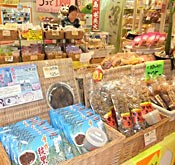
May 8, 2012 Fumitaki Jahana of Ryukyu Shimpo
2011 to 2012 was a lean season for sugar cane in Okinawa. The shortage of raw materials led to a decrease in production of chunks of Okinawan brown sugar, which in turn pushed the selling price up. The problem of short supply came after the over stock of the previous year was resolved. A branding campaign was carried out from April in conjunction with the tightening of labeling requirements of origin for chunks of brown sugar, and officials commented, “The increased demand for chunks of Okinawan brown sugar means that these production cutbacks have caused significant losses in potential business.”
One of the main factories, Tarama, which is owned by Miyako Sugar Manufacturing, also reduced its production significantly to 1946 tons from the previous level of between 3500 and 3700 tons. According to a spokesperson for the company, the average price of chunks of brown sugar has risen by 30 yen compared to that of the previous season, which was 230 to 235 yen for 30 kilograms. JA Okinawa, which operates five factories in Okinawa, also had its price go up 10 yen from the average, with the wholesale price becoming 230 yen.
Markets have been affected by this increase in wholesale prices. Kokutoya, a specialty shop selling chunks of brown sugar increased the price by about 20 to 30 yen per 100 grams for almost all of its commodities. Kokutoya company president Masami Aragaki said, “A labeling system has just started. Cuts in production at this stage were not what we expected. We may need to be flexible and reduce the proportion of molasses to use as sugar. I think we can somehow meet market demand.”
Last year, the Okinawa Products Associated Co. Ltd. exported 20 tons of brown sugar chunks to Taiwan and Hong Kong. An official said, “Demand exceeds supply.” On a weight basis, there is ten times more demand than supply, but supply is only about 10% of that of last year. The official said, “We have been affected by natural disasters, but the cut in output has affected confidence in our ability to supply market needs. Availability of raw material is crucial in our business. The introduction of the labeling system drove up demand, so this is a double whammy for us. We really hope that next season will be better.”
(English translation by T&CT, Shinako Oyakawa and Mark Ealey)
Go to Japanese
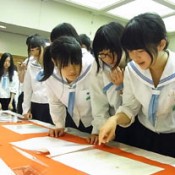
May 8, 2012 Ryukyu Shimpo
On May 7, 80 students from Hikone City Nishi Junior High School in Shiga Prefecture visited the Okinawa Prefectural Library on a school trip and saw the original lyrics of their school song written by a poet from Okinawa, Baku Yamanokuchi.
The 27 page-long lyrics were found in 2010. According to Nishi Junior High School, the school’s second principal, Morimatsu Ota, was from Okinawa and asked his friend Baku to write a song for the school. Pencil and fountain pen marks on the lyrics suggest that Baku made many revisions.
In far away Okinawa from Shiga, students saw the process of writing the song that they have been singing. Fourteen year-old Mikako Nakae said, “I feel the connection with Okinawa. I want to get to know about the school song.” Fifteen year-old Yuyako Kobori said, “The song was revised so many times. I understand his passion towards it.”
(English translation by T&CT, Megumi Chibana and Mark Ealey)
Go to Japanese
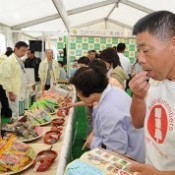
May 11, 2012 Ryukyu Shimpo
On May 10, or Brown Sugar Day, the Okinawa Non-Centrifugal Sugar Countermeasure Conference held an event promoting the consumption and sale of chunks of Okinawan brown sugar in the plaza in front of Palette Kumoji. Organizations related to the event will run a campaign to boost consumption of chunks of brown sugar both in and out of Okinawa through until September 6. A tasting party for chunks of brown sugar produced in eight regions in Okinawa, as well as ice cream and drinks made from brown sugar was held. Takashi Tanahara, a chef who specializes in French cuisine, entertained visitors with a cooking demonstration of sweets made from chunks of brown sugar.
Takeshi Chinen, head of the Agriculture, Forestry and Fisheries Department of the Okinawa General Bureau, delivered a speech, saying, “Chunks of brown sugar have supported the lives of Okinawan people and supported the economies of remote islands. We would like to let people all over Japan know about the appeal of Okinawan brown sugar.”
According to the Sugar Industry and Agricultural Products Division of the Okinawa Prefectural Government, production volume during 2011 to 2012 of sugarcane, a basic ingredient of lumps of brown sugar, is estimated to be about 5600 tons, a drastic decrease from the 8339 tons for the same period the previous year.
Iwao Kinjo, the senior managing director of the Okinawa branch of the Japan Agricultural Cooperatives, said, “Sugarcane production was tough last year. We want to work with related organizations to improve things.”
(English translation by T&CT, Mark Ealey)
Go to Japanese

Go To Video
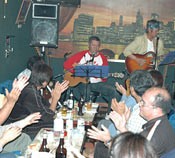
May 9, 2012 Ryukyu Shimpo
To revitalize Henoko in Nago, the Henoko Light Music Club, an amateur music group of local musicians gave a lively performance. On April 28, four bands played folk songs at a restaurant in Henoko, with people enjoying the music in the hope that the performance will help in some way to restore vitality to the area.
The club was established by Munetaka Kayo three years ago and since then they have given on-site live performances once a month in the community.
According to Kayo, there are ten bands in Henoko alone, and they have held live performances of folk music, Okinawan folk songs, hip-hop, and rock with other community bands. In the first part of the performance, high-school students play, with their performances having been well received by the adults.
Kayo explained that the reason for starting up the club was that in the past Henoko has produced many personalities who are active in sports and drama, such as Koya Higa, the baseball manager at Okinawa Shogaku High School and actress Meisa Kuroki, and he hopes to develop a singer-song-writer from the area. “When we were children, during the Vietnam War, Henoko was swarming with people including U.S. military personnel. While the times have changed, I want to do something to help revive this community,” he said.
Akihiro Iida, the president of the Henoko Commerce and Industry Association, said, “While Henoko has become known throughout Japan because of matters surrounding the U.S. military base, this doesn’t help promote the development of the town. The younger generation has been active to boost the local community, and I would like to support them.”
The next live performance, the “Day of Rock” is scheduled for June 9 from 8:00pm, at Pub Pony. For further details, please refer to the official blog of the Club.
Website: http://henokokeion.seesaa.net/
(English translation by T&CT, Lima Tokumori and Mark Ealey)
Go to Japanese
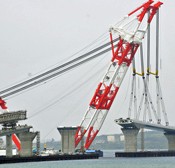
May 5, 2012 Ryukyu Shimpo
On April 28, at Miyakojima City, bridging work commenced on the Irabu-Ohashi between Irabu Island and Miyako Island. On the Irabu Island side of the bridge, the second-largest crane ship in Japan, which is capable of lifting and installing offshore structures up to 4000 tons in weight and is 145 meters high at the tip of its arm, arrived at the construction site where it placed a steel box girder 1300 tons in weight and 140 meters long on the bridge.
At around 6:00am, the giant crane ship lifted a huge box girder from the Shimosaki pier at the Hirara Harbor and moved it to the construction site of Irabu Island. The work was carried out very carefully and was completed at around 10:30am. An observation tour was held at the construction site. When the crane ship was working, many local people and tourists visited the Touriba district of Hirara and the Makiyama Sightseeing Tower on Irabu from where they took photographs.
Akihiro Miyaguni, a fifth-grade pupil of Minami Elementary School who came with his family, said, “I’ve hardly ever seen a construction site before. It was for me amazing and really cool to see the crane ship.” The main construction has three parts to it: the central section, plus the sites of Irabu Island and Miyako Island. The construction work for the central section had been scheduled to be carried out initially on April 26, but was postponed due to bad weather. The operation for the Miyako Island side will be carried out on May 11, and the central part has been scheduled for around the end of May.
(English translation by T&CT, Mark Ealey)
Go to Japanese
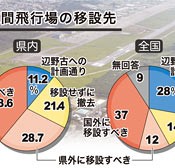
May 9, 2012 Ryukyu Shimpo
On May 5 and 6, ahead of May 15, the 40th anniversary of Okinawa’s reversion to Japanese sovereignty, the Ryukyu Shimpo and Mainichi newspapers jointly conducted a telephone opinion poll to ascertain how people in Okinawa and the main islands of Japan view the reversion and issues related to the U.S. military bases in Okinawa. With regard to the relocation of the U.S. Marine Corps Air Station Futenma, 90% of people in Okinawa and more than 60% of those in the main islands of Japan call for the relocation of the base outside Okinawa or Japan. They also demand that U.S. forces unconditionally return to Okinawa land currently occupied by bases. But at the same time, while 70% of people in Okinawa are aware of the unfairness of the situation in which 74% of the U.S. military bases in Japan are concentrated in Okinawa, no more than 30% of people on the main islands of Japan see things that way. Among the policies that people in Okinawa want the prefectural and central governments to implement, 43% of residents demanded the scaling-down of U.S. bases in Okinawa and the redevelopment of land currently used for bases, a figure that exceeds that for the desire to promote economic activity. The people of Okinawa have clearly indicated that for the sake of Okinawa they wish to see the return of U.S. bases and the redevelopment of land used by military bases.
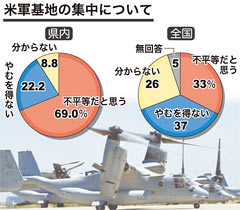
Regarding the heavy concentration of U.S. military facilities in Okinawa.
With regard to Okinawa’s reversion to Japan, 80% of Okinawans surveyed said it was “Very good” or “Rather good.” That category of people accounted for 79% of people in 2002, the year marking the 30th anniversary of the reversion, and 82% in 2007, which marked the 35th anniversary. Among those people surveyed on the main islands of Japan, the response, “Good,” accounted for 79%, far exceeding those who said, “Bad,” who accounted for just 3% and “Not sure” for 14%.
With regard to the planned relocation of Futenma Air Station to the Henoko district of Nago, 39% of people in Okinawa demanded its relocation out of Japan, 29% want it relocated out of Okinawa and 21% demanded the return of land occupied by the base to Okinawa instead of relocation, making a total of 89%. Just 11% supported adherence to the current plan. While 28% of the people in the main islands of Japan called for adherence to the plan, 68% opposed relocation of the U.S. bases in Okinawa to their own regions.
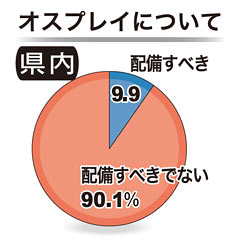
Regarding the deployment of the Osprey to Futenma Air Station.
With regard to the MV-22 Osprey vertical take-off and landing transport aircraft scheduled to be deployed to the Futenma Air Station in July, 90% of people in Okinawa said, “The Osprey should not be deployed to the base,” clearly expressing strong opposition to the deployment.
As many as 85% of people in Okinawa and 82% of people in the main islands of Japan said that they, “Feel insecure” about China’s military advances to the East China Sea. With regard to how to resolve this, 65% of people in Okinawa and 66% of people in the main islands of Japan supported diplomatic solutions, far outnumbering those who support a buildup of Japan’s defense capability, who accounted for 20% in Okinawa and 26% nationwide.
◇The article rounds the statistical data off to the closest whole number. The total may not become 100%.
Go to Japanese
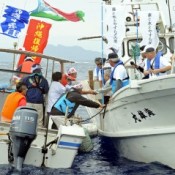
April 29, 2012 Ryota Nakamura of Ryukyu Shimpo
On April 28, a meeting by people of Kunigami and Yoron took place on the sea at the northern latitude of 27 degrees. This used to be where the border was after the Amami Islands were returned to Japanese sovereignty in 1953. They reenacted the meeting demanding Okinawan reversion to Japan. Sixty years have passed since the San Francisco Conference on the Japan Peace Treaty in 1952, and Okinawa and Amami Islands were separated from Japan on that day. At the meeting, Kunigami’s Mayor Hisakazu Miyagi and Sairyo Fumoto, the chairman of the Commemorative Event Committee, shook hands and read out the peace declaration. They hope to promote deeper mutual exchanges and pass on the memory of the territorial separation to the next generation.
In the declaration, Miyagi said, “April 28th is the day that we achieved that long sought after reversion. We had to live under U.S. military occupation for 27 years, and while Okinawa has returned to Japanese sovereignty, 74% of the U.S. military facilities in Japan are still concentrated in our prefecture, causing large amounts of trouble and crime. I believe that we have to reflect on our 67 years of postwar history and tell our children about it.”
Driven by the desire to return to Japanese sovereignty, meetings on the sea took place in the years between 1963 and 1969.

The border point before Okinawa’s reversion (northern latitude of 27 degrees).
At 11:30am on 28 April, twenty-five fishing boats and sabani, or Okinawan traditional vessels met at the northern latitude of 27 degrees with 130 people participating. A ferry carrying school children from Kunigami to take part in an exchange program in Yoron also circled around the meeting.
Boats from Kunigami and Yoron were tethered while Miyagi and Fumoto read out the peace declaration. Following the declaration, the people on board sang the symbolic song Okinawa wo kaese which translates as Give Okinawa Back to Us.
During the meeting the participants waved and spoke to each other for about 30 minutes. A horn was sounded and those on the boats reluctantly parted. Miyagi said, “I felt a lump in my throat. I think it is important to question the excessive burden of the U.S. military on Okinawa.”
After the meeting out on the sea, there was a 40th anniversary event at Cape Hedo. Muneaki Ura who was born in 1972, the year that Okinawa reverted to Japanese sovereignty, offered a peace declaration, “We reflect on the original intention of seeking an Okinawa without military bases and longing for lasting peace.”
(English translation by T&CT, Shinako Oyakawa and Mark Ealey)
Go to Japanese
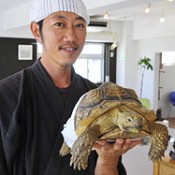
April 30, 2012 Yugo Okita of Ryukyu Shimpo
Facebook, a social networking service, helped to solve a case in which a tortoise climbed through a fence and became lost.
The tortoise that went missing was Tobio, a female African spurred tortoise belonging to Kyuma Yasui, who works for Seasah-story, a pottery studio on Miyako Island. Her slow movement and reassuring figure is popular with children and tourists who visit the shop.
In the morning of April 7, Yasui put the tortoise out on the lawn near the studio while he cleaned the inside of the shop, but she got through the wire fence and escaped. Tobio has done this several times in the past, but her slow movements have usually meant that she has soon been tracked down near the shop.
However, on this occasion, Satoshi Ikema, who was passing by at around 11:00am, found Tobio on the sidewalk. There was no one around and he didn’t know who the owner was, so he picked her up to protect her from the passing traffic. Ikema posted on his Facebook immediately that “I’m looking after a stray tortoise.”
By this stage Yasui had noticed that Tobio had disappeared and had started to look for her. He reported his loss to the police and had moved to advertise in the local newspaper to find the tortoise. He also asked on Facebook but he “did not really have great expectations of finding her.”
After Yasui posted the comment, his friend also stated that “A friend of mine is looking for his missing tortoise,” on Facebook. Another person who saw the message knew that this was the same tortoise that Ikema was now looking after. Yasui was then able to find Tobio about an hour after Ikema picked her up, and was reunited with her just three hours later.
Yasui said, “I was relieved when she came back safely. Facebook is marvelous. I’m very happy that I joined it.”
(English translation by T&CT, Lima Tokumori and Mark Ealey)
Go to japanese
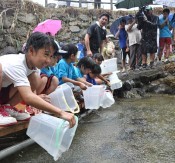
May 2, 2012 Ryukyu Shimpo
On April 29, at the Genka River in Nago, about 50 pupils of Genka Elementary School released approximately 1000 fry of the Ryukyu-ayu or Plecoglossus Altivelis Ryukyuensis (sweetfish). The pupils dropped the juvenile fish into the river from the bridge from their small buckets and hoped that they will become bigger.
The three-centimeter long Ryukyu-ayu are fry that the Okinawa Churaumi Aquarium farmed artificially hatched four months ago. Since 1988, Genka Ward has aimed to increase the sweet fish population by stocking the river with them.
Hatsuo Oyakawa, the head of Genka Ward said, “It is necessary to release the sweet fish to revitalize Genka River which can be hear the sounds of their jumping like it used to be.” Yu Christina Nago, a fifth grade pupil of Genka Elementary School, who released the fish, said with a smile, “They were so small and cute. I hope that they grow big and come back.”
Genka Ward held the 19th Sweetfish Streamer Festival. By May 13, a total of about 150 sweetfish streamers made by local children will be flown around the Genka Community Hall.
(English translation by T&CT, Lima Tokumori and Mark Ealey)
Go to Japanese
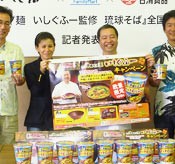
May 2, 2012 Ryukyu Shimpo
On May 1, the Okinawa branch of FamilyMart launched a pot noodle called “Ryukyu soba overseen by Ishigufu.” The Okinawa soba restaurant Ishigufu and FamilyMart, Japan’s third largest convenience store chain, cooperated with Nissin Foods to develop the product, which will be sold in a limited quantity at about 8900 branches all over Japan.
The branch store developed the pot noodle to celebrate its 25th year in business. According to a representative of the store, the noodle has a smooth texture, making it pleasant to consume. It is accompanied by a plain soup made from bonito and pork.
FamilyMart will sell 36000 units in Okinawa and another 144000 outside of the prefecture in a limited quantity. The price is 198 yen including tax.
Ishigufu is an Okinawa soba chain restaurant with five branches in Okinawa. It became the first champion of the televised Okinawa soba competition featuring popular Okinawa soba restaurants in the prefecture. Ishigufu serves handmade noodles with soup made from agu pork, an Okinawan traditional breed.

The pot noodle called "Ryukyu soba overseen by Ishigufu."
On May 1, FamilyMart Naha President Goichi Itokazu held a press conference at the Okinawa Prefectural Office, at which he said, “This is the first time that FamilyMart has created a pot noodle in cooperation with a popular Okinawa soba restaurant. We would like to let customers all over the country know about the charm of Okinawa soba through our nationwide distribution.” The head of Ishigufu, Ken Ikehara, said, “I sense that young people are tending to shy away from Okinawa soba. We want to create a new genre of Okinawa soba called Ryukyu soba, through which we hope that Okinawa soba can once again attract attention.”
(English translation by T&CT, Mark Ealey)
Go to Japanese
















 Webcam(Kokusai Street)
Webcam(Kokusai Street)


